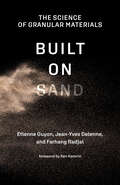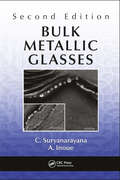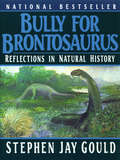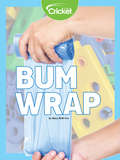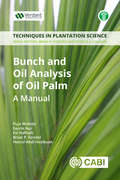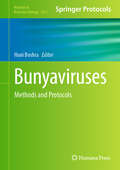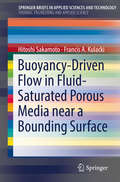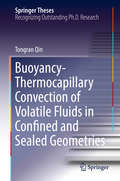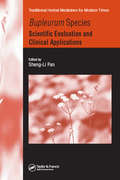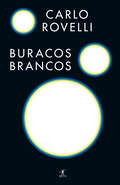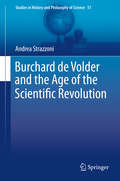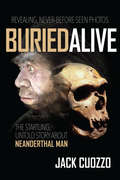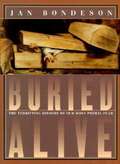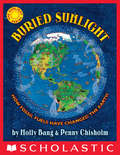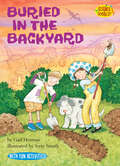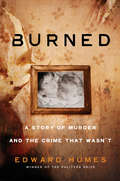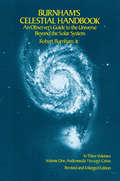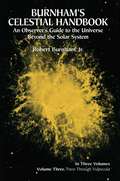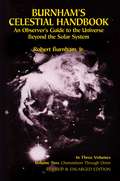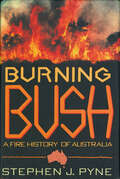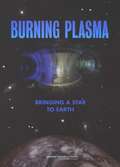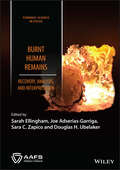- Table View
- List View
Built on Sand: The Science of Granular Materials
by Etienne Guyon Jean-Yves Delenne Farhang RadjaiExplaining the science contained in a simple assembly of grains—the most abundant form of matter present on Earth.Granular media—composed of vast amounts of grains, consolidated or not—constitute the most abundant form of solid matter on Earth. Granular materials assemble in disordered configurations scientists often liken to a bag of marbles. Made of macroscopic particles rather than molecules, they defy the standard scheme of classification in terms of solid, liquid, and gas. Granular materials provide a model relevant to various domains of research, including engineering, physics, and biology. William Blake famously wished “To See a World in a Grain of Sand”; in this book, pioneering researchers in granular matter explain the science hidden behind simple grains, shedding light on collective behavior in disordered settings in general.The authors begin by describing the single grain with its different origins, shapes, and sizes, then examine grains in piled or stacked form. They explain the packing fraction of granular media, a crucial issue that bears on the properties displayed in practical applications; explore small-scale deformations in piles of disordered grains, with particular attention to friction; and present theories of various modes of disorder. Along the way, they discuss such concepts as force chains, arching effects, wet grains, sticky contacts, and inertial effects. Drawing on recent numerical simulations as well as classical concepts developed in physics and mechanics, the book offers an accessible introduction to a rapidly developing field.
Bulk Metallic Glasses: 2002 Mrs Fall Meeting, Boston, Ma (Mrs Proceedings Ser. #754)
by C. Suryanarayana A. InoueReflecting the fast pace of research in the field, the Second Edition of Bulk Metallic Glasses has been thoroughly updated and remains essential reading on the subject. It incorporates major advances in glass forming ability, corrosion behavior, and mechanical properties. Several of the newly proposed criteria to predict the glass-forming ability of alloys have been discussed. All other areas covered in this book have been updated, with special emphasis on topics where significant advances have occurred. <P><P> These include processing of hierarchical surface structures and synthesis of nanophase composites using the chemical behavior of bulk metallic glasses and the development of novel bulk metallic glasses with high-strength and high-ductility and superelastic behavior. New topics such as high-entropy bulk metallic glasses, nanoporous alloys, novel nanocrystalline alloys, and soft magnetic glassy alloys with high saturation magnetization have also been discussed. Novel applications, such as metallic glassy screw bolts, surface coatings, hyperthermia glasses, ultra-thin mirrors and pressure sensors, mobile phone casing, and degradable biomedical materials, are described. Authored by the world’s foremost experts on bulk metallic glasses, this new edition endures as an indispensable reference and continues to be a one-stop resource on all aspects of bulk metallic glasses.
Bully for Brontosaurus: Reflections in Natural History
by Stephen Jay Gould"Provocative and delightfully discursive essays on natural history. . . . Gould is the Stan Musial of essay writing. He can work himself into a corkscrew of ideas and improbable allusions paragraph after paragraph and then, uncoiling, hit it with such power that his fans know they are experiencing the game of essay writing at its best."--John Noble Wilford, New York Times Book Review
Bum Wrap
by Mary Beth CoxPlastic was once considered the material of the future, but now it has become a nuisance that results in too much trash for the planet to handle. Learn about the durability and longevity of this 19th-century invention and hear recycling ideas from a chemist who hopes to salvage plastic's reputation.
Bunch and Oil Analysis of Oil Palm: A Manual (Techniques in Plantation Science #7)
by Brian Forster Fazrin Nur Pujo Widodo Evi Nafisah Hasrul Abdi HasibuanThis is a hands-on, practical guide to describe physical bunch and oil analysis of oil palm. Bunch and oil analysis laboratories are set up at oil mills to assess production, yield potential of plantations and oil extraction rates relative to targets. The higher the oil yields produced by the planting material, the less land that is needed to achieve a specific level of production, hence helping in the sustainability of the crop. Practical, illustrated steps are given in determining bunch and oil characteristics of oil palm. Promoting green, eco-friendly agriculture, this book covers: An introduction to bunch and oil analysis Health and safety considerations Bunch sampling Physical bunch analysis of stalks, spikelets, fruits and nuts Fruit sampling Nut analysis and measurements of components Oil analysis, oil extraction and measurement Calculation of bunch components and reporting. This is an invaluable manual for oil palm mill managers, oil palm plantation managers, palm oil producers, oil palm breeders, agronomists, oil chemists, oil palm seed producing companies and research institutes across the world (especially tropical zones). It is useful for those starting a career in oil palm production, as a reference guide for managers and for training purposes.
Bunch and Oil Analysis of Oil Palm: A Manual (Techniques in Plantation Science #7)
by Brian Forster Fazrin Nur Pujo Widodo Evi Nafisah Hasrul Abdi HasibuanThis is a hands-on, practical guide to describe physical bunch and oil analysis of oil palm. Bunch and oil analysis laboratories are set up at oil mills to assess production, yield potential of plantations and oil extraction rates relative to targets. The higher the oil yields produced by the planting material, the less land that is needed to achieve a specific level of production, hence helping in the sustainability of the crop. Practical, illustrated steps are given in determining bunch and oil characteristics of oil palm. Promoting green, eco-friendly agriculture, this book covers: An introduction to bunch and oil analysis Health and safety considerations Bunch sampling Physical bunch analysis of stalks, spikelets, fruits and nuts Fruit sampling Nut analysis and measurements of components Oil analysis, oil extraction and measurement Calculation of bunch components and reporting. This is an invaluable manual for oil palm mill managers, oil palm plantation managers, palm oil producers, oil palm breeders, agronomists, oil chemists, oil palm seed producing companies and research institutes across the world (especially tropical zones). It is useful for those starting a career in oil palm production, as a reference guide for managers and for training purposes.
Bunyaviruses: Methods and Protocols (Methods in Molecular Biology #2893)
by Hani BoshraThis volume explores the latest advancements in the study of bunyaviruses. The chapters in this book cover topics such as virus manipulation and purification; expression of recombinant proteins; the experimental study of bunyavirus infection in animals for virological and immunological analysis; and plant bunyaviruses. Written in the highly successful Methods in Molecular Biology series format, chapters include introductions to their respective topics, lists of the necessary materials and reagents, step-by-step, readily reproducible laboratory protocols, and tips on trouble shooting and avoiding known pitfalls. Comprehensive and cutting-edge, Bunyaviruses: Methods and Protocols is a valuable resource for both expert and novice scientists who are interested in learning more about this important and developing field.
Buoyancy Effects on Natural Ventilation
by Torwong ChenvidyakarnThis book describes in depth the fundamental effects of buoyancy, a key force in driving air and transporting heat and pollutants around the interior of a building. This book is essential reading for anyone involved in the design and operation of modern sustainable, energy-efficient buildings, whether a student, researcher or practitioner. The book presents new principles in natural ventilation design and addresses surprising, little-known natural ventilation phenomena that are seldom taught in architecture or engineering schools. Despite its scientific and applied mathematics subject, the book is written in simple language and contains no demanding mathematics, while still covering both qualitative and quantitative aspects of ventilation flow analysis. It is therefore suitable for both non-expert readers who just want to develop intuition of natural ventilation design and control (such as architects and students) and for those possessing more expertise whose work involves quantifying flows (such as engineers and building scientists).
Buoyancy-Driven Flow in Fluid-Saturated Porous Media near a Bounding Surface (SpringerBriefs in Applied Sciences and Technology)
by Francis A. Kulacki Hitoshi SakamotoThis Brief reports on heat transfer from a solid boundary in a saturated porous medium. Experiments reveal overall heat transfer laws when the flow along the wall is driven by buoyancy produced by large temperature differences, and mathematical analysis using advanced volume-averaging techniques produce estimates of how heat is dispersed in the porous zone. Engineers, hydrologists and geophysicists will find the results valuable for validation of laboratory and field tests, as well as testing their models of dispersion of heat and mass in saturated media.
Buoyancy-Driven Flows
by Eric P. Chassignet Claudia Cenedese Jacques VerronBuoyancy is one of the main forces driving flows on our planet, especially in the oceans and atmosphere. These flows range from buoyant coastal currents to dense overflows in the ocean, and from avalanches to volcanic pyroclastic flows on the Earth's surface. This book brings together contributions by leading world scientists to summarize our present theoretical, observational, experimental, and modeling understanding of buoyancy-driven flows. Buoyancy-driven currents play a key role in the global ocean circulation and in climate variability through their impact on deep-water formation. Buoyancy-driven currents are also primarily responsible for the redistribution of fresh water throughout the world's oceans. This book is an invaluable resource for advanced students and researchers in oceanography, geophysical fluid dynamics, atmospheric science, and the wider Earth sciences who need a state-of-the-art reference on buoyancy-driven flows.
Buoyancy-Thermocapillary Convection of Volatile Fluids in Confined and Sealed Geometries (Springer Theses)
by Tongran QinThis thesis represents the first systematic description of the two-phase flow problem. Two-phase flows of volatile fluids in confined geometries driven by an applied temperature gradient play an important role in a range of applications, including thermal management, such as heat pipes, thermosyphons, capillary pumped loops and other evaporative cooling devices. Previously, this problem has been addressed using a piecemeal approach that relied heavily on correlations and unproven assumptions, and the science and technology behind heat pipes have barely evolved in recent decades. The model introduced in this thesis, however, presents a comprehensive physically based description of both the liquid and the gas phase. The model has been implemented numerically and successfully validated against the available experimental data, and the numerical results are used to determine the key physical processes that control the heat and mass flow and describe the flow stability. One of the key contributions of this thesis work is the description of the role of noncondensables, such as air, on transport. In particular, it is shown that many of the assumptions used by current engineering models of evaporative cooling devices are based on experiments conducted at atmospheric pressures, and these assumptions break down partially or completely when most of the noncondensables are removed, requiring a new modeling approach presented in the thesis. Moreover, Numerical solutions are used to motivate and justify a simplified analytical description of transport in both the liquid and the gas layer, which can be used to describe flow stability and determine the critical Marangoni number and wavelength describing the onset of the convective pattern. As a result, the results presented in the thesis should be of interest both to engineers working in heat transfer and researchers interested in fluid dynamics and pattern formation.
Bupleurum Species: Scientific Evaluation and Clinical Applications (Traditional Herbal Medicines For Modern Times Ser.)
by Sheng-Li PanThe prominence of the Bupleurum species cannot be overstated. Across China and Japan, it serves as a main or supplementary ingredient in over two thirds of traditional medications. For over 2000 years, it has been used to treat fevers, intestinal maladies, malaria, and countless other afflictions. Modern research indicates that it may possess anti-
Buracos brancos
by Carlo RovelliDo autor de Sete breves lições de Física, uma indagação sobre um tema absolutamente misterioso e inovador: os buracos brancos. «chegamos à borda do horizonte de um buraco negro, entramos, descemos ao fundo, onde o espaço e o tempo se fundem, atravessamo-lo, ressurgimos no buraco branco, onde o tempo se inverte, e daí emergimos no futuro. comecemos, pois, a nossa viagem em direção aos buracos brancos.»Depois de uma aturada investigação sobre os buracos negros, Carlo Rovelli, físico italiano, dedicou-se à possibilidade de estes se transformarem em buracos brancos. Mas o que são os buracos brancos? Existem, de facto? Que mudanças no espaço e no tempo, no cerne de um buraco negro, os tornam possíveis? Poderá o tempo mudar de direção? Rovelli, um dos mais consagrados físicos da atualidade, guia-nos pelas suas respostas a estas indagações e pelo caminho, entre a inquietação e o entusiasmo, que percorreu até as encontrar. Uma ode ao método científico, Buracos brancos explora estes esquivos objetos e as suas implicações para a nossa perspetiva do que é o tempo. Os elogios da crítica: «Rovelli, físico de prestígio internacional, entretece Dante, Einstein e arte numa escrita de tal modo enfeitiçante que o leitor tem prazer em se deixar levar.» The Bookseller «O novo Stephen Hawking.»The Sunday Times «Rovelli é um génio, um comunicador incrível.» Neil Gaiman
Burchard de Volder and the Age of the Scientific Revolution (Studies in History and Philosophy of Science #51)
by Andrea StrazzoniThis monograph details the entire scientific thought of an influential natural philosopher whose contributions, unfortunately, have become obscured by the pages of history. Readers will discover an important thinker: Burchard de Volder. He was instrumental in founding the first experimental cabinet at a European University in 1675.The author goes beyond the familiar image of De Volder as a forerunner of Newtonianism in Continental Europe. He consults neglected materials, including handwritten sources, and takes into account new historiographical categories. His investigation maps the thought of an author who did not sit with an univocal philosophical school, but critically dealt with all the ‘major’ philosophers and scientists of his age: from Descartes to Newton, via Spinoza, Boyle, Huygens, Bernoulli, and Leibniz. It explores the way De Volder’s un-systematic thought used, rejected, and re-shaped their theories and approaches. In addition, the title includes transcriptions of De Volder's teaching materials: disputations, dictations, and notes.Insightful analysis combined with a trove of primary source material will help readers gain a new perspective on a thinker so far mostly ignored by scholars. They will find a thoughtful figure who engaged with early modern science and developed a place that fostered experimental philosophy.
Buried Alive
by Jack CuozzoSince the first cave discoveries in Germany's Neander Valley, we have been fascinated by these thick-browned, powerful creatures. Who were they and where did they go? A centerpiece in the study of human evolution, Neanderthal Man has, by his own mysterious demise, created more questions than he has answered. But what if Neanderthals could answer for themselves and tell us about their origins?Now, for the first time, that is possible through the original research of Jack Cuozzo. Fascinated by Neanderthal Man for over two decades, Cuozzo, an orthodontist, has fashioned a research book that will clutch the attention of scientists and laypersons alike, for the Neanderthal family has finally emerged to tell a shocking story. * 16 page photo section
Buried Alive: The Terrifying History Of Our Most Primal Fear
by Jan BondesonReaders of Edgar Allan Poe's tales--just think of The Premature Burial--may comfort themselves with the notion that Poe must have exaggerated: surely people of the 1800s could not have been at risk of being buried alive? But such stories filled medical journals as well as fiction, and fear in the populace was high. It was speculated, from the number of skeletons found in horrific, contorted positions inside their coffins, that ten out of every one hundred people were buried before they were dead. With over fifty illustrations, Buried Alive explores the medicine, folklore, history, and literature of Europe and the United States to uncover why such fears arose and whether they were warranted.
Buried Sunlight: How Fossil Fuels Have Changed the Earth
by Molly Bang Penny ChisholmAcclaimed Caldecott Artist Molly Bang teams up with award-winning M.I.T. professor Penny Chisholm to present the fascinating, timely story of fossil fuels. What are fossil fuels, and how did they come to exist? This engaging, stunning book explains how coal, oil, and gas are really "buried sunlight," trapped beneath the surface of our planet for millions and millions of years. Now, in a very short time, we are digging them up and burning them, changing the carbon balance of our planet's air and water. What does this mean, and what should we do about it? Using simple language and breathtaking paintings, Bang and Chisholm present a clear, concise explanation of the fossil-fuel energy cycle that began with the sun and now runs most of our transportation and energy use in our world. Readers will be mesmerized by this engaging fourth book in the award-winning Sunlight Series by Bang and Chisholm.
Buried in the Backyard (Science Solves It!)
by Gail HermanSolve kid-sized dilemmas and mysteries with the Science Solves It! series. These fun science books for kids ages 5–8 blend clever stories with real-life science. Why did the dog turn green? Can you control a hiccup? Is that a UFO? Find the answers to these questions and more as kid characters dive into physical, life, and earth sciences. While trying to dig a pool for themselves, Ryan and Kate discover a very large, old bone-right in their own backyard! Amazingly, it turns out to be the fossilized bone of a Woolly Mammoth! Books in this perfect STEM series will help kids think like scientists and get ahead in the classroom. Activities and experiments are included in every book! (Level One; Science topic: Woolly Mammoths)
Burned: A Story of Murder and the Crime That Wasn't
by Edward HumesWas a monstrous killer brought to justice or an innocent mother condemned?On an April night in 1989, Jo Ann Parks survived a house fire that claimed the lives of her three small children. Though the fire at first seemed a tragic accident, investigators soon reported finding evidence proving that Parks had sabotaged wiring, set several fires herself, and even barricade her four-year-old son inside a closet to prevent his escape. Though she insisted she did nothing wrong, Jo Ann parks received a life sentence without parole based on the power of forensic fire science that convincingly proved her guilt.But more than a quarter century later, a revolution in the science of fire has exposed many of the incontrovertible truths of 1989 as guesswork in disguise. The California Innocence Project is challenging Parks's conviction and the so-called science behind it, claiming that false assumptions and outright bias convicted an innocent mother of a crime that never actually happened.If Parks is exonerated, she could well be the "Patient Zero" in an epidemic of overturned guilty verdicts--but only if she wins. Can prosecutors dredge up enough evidence and roadblocks to make sure Jo Ann Parks dies in prison? No matter how her last-ditch effort for freedom turns out, the scenes of betrayal, ruin, and hope will leave readers longing for justice we can trust.
Burnham's Celestial Handbook, Volume One: An Observer's Guide to the Universe Beyond the Solar System (Dover Books on Astronomy #1)
by Robert Burnham Jr.While there are many books on stars, there is only one Celestial Handbook. Now completely revised through 1977, this unique and necessary reference is available once again to guide amateur and advanced astronomers in their knowledge and enjoyment of the stars.Volume I of this comprehensive three-part guide to the thousands of celestial objects outside our solar system ranges from Andromeda through Cetus. Objects are grouped according to constellation, and their definitions feature names, coordinates, classifications, and physical descriptions. After an extensive introduction in Volume I, which gives the beginner enough information to follow about 80 percent of the body of the material, the author gives comprehensive coverage to the thousands of celestial objects outside our solar system that are within the range of telescopes in the two- to twelve-inch range.The objects are grouped according to the constellations in which they appear. Each constellation is divided into four subject sections: list of double and multiple stars; list of variable stars; list of star clusters, nebulae and galaxies; and descriptive notes. For each object the author gives names, celestial coordinates, classification, and full physical description. These, together with a star atlas, will help you find and identify almost every object of interest.But the joy of the book is the descriptive notes that follow. They cover history, unusual movements or appearance, and currently accepted explanations of such visible phenomena as white dwarfs, novae and super novae, cepheids, mira-type variables, dark nebulae, gaseous nebulae, eclipsing binary stars, the large Magellanic cloud, the evolution of a star cluster, and hundreds of other topics, many of which are difficult to find in one place. Hundreds of charts and other visual aids are included to help in identification. Over 300 photographs capture the objects and are works of beauty that reflect the enthusiasm that star gazers have for their subject.Robert Burnham, Jr., who was on the staff of the Lowell Observatory, Flagstaff, Arizona, conceived the idea of The Celestial Handbook decades ago, when he began assembling a notebook of all the major facts published about each celestial object. In its former, privately printed edition, this handbook was acclaimed as one of the most helpful books for astronomers on any level.
Burnham's Celestial Handbook, Volume Three: An Observer's Guide to the Universe Beyond the Solar System (Dover Books on Astronomy #3)
by Robert Burnham Jr.Volume III of a comprehensive three-part guide to celestial objects outside our solar system concludes with listings from Pavo to Vulpecula. While there are many books on stars, there is only one Celestial Handbook. Now completely revised through 1977, this unique and necessary reference is available once again to guide amateur and advanced astronomers in their knowledge and enjoyment of the stars.After an extensive introduction in Volume I, which gives the beginner enough information to follow about 80 percent of the body of the material, the author gives comprehensive coverage to the thousands of celestial objects outside our solar system that are within the range of telescopes in the two- to twelve-inch range.The objects are grouped according to the constellations in which they appear. Each constellation is divided into four subject sections: list of double and multiple stars; list of variable stars; list of star clusters, nebulae and galaxies; and descriptive notes. For each object the author gives names, celestial coordinates, classification, and full physical description. These, together with a star atlas, will help you find and identify almost every object of interest.But the joy of the book is the descriptive notes that follow. They cover history, unusual movements or appearance, and currently accepted explanations of such visible phenomena as white dwarfs, novae and super novae, cepheids, mira-type variables, dark nebulae, gaseous nebulae, eclipsing binary stars, the large Magellanic cloud, the evolution of a star cluster, and hundreds of other topics, many of which are difficult to find in one place. Hundreds of charts and other visual aids are included to help in identification. Over 300 photographs capture the objects and are works of beauty that reflect the enthusiasm that star gazers have for their subject.Robert Burnham, Jr., who was on the staff of the Lowell Observatory, Flagstaff, Arizona, conceived the idea of The Celestial Handbook decades ago, when he began assembling a notebook of all the major facts published about each celestial object. In its former, privately printed edition, this handbook was acclaimed as one of the most helpful books for astronomers on any level.
Burnham's Celestial Handbook: An Observer's Guide to the Universe Beyond the Solar System (Chameleon Through Orion #Volume Two)
by Robert Burnham Jr.Chamaeleon Through OrionWhile there are many books on stars, there is only one Celestial Handbook. Now completely revised through 1977, this unique and necessary reference is available once again to guide amateur and advanced astronomers in their knowledge and enjoyment of the stars. After an extensive introduction in Volume I, which gives the beginner enough information to follow about 80 percent of the body of the material, the author gives comprehensive coverage to the thousands of celestial objects outside our solar system that are within the range of telescopes in the two- to twelve-inch range. The objects are grouped according to the constellations in which they appear. Each constellation is divided into four subject sections: list of double and multiple stars; list of variable stars; list of star clusters, nebulae, and galaxies; and descriptive notes. For each object the author gives names, celestial coordinates, classification, and full physical description. These, together with a star atlas, will help you find and identify almost every object of interest. But the joy of the book is the descriptive notes that follow. They cover history, unusual movements or appearances, and currently accepted explanations of such visible phenomena as white dwarfs, novae and supernovae, cepheids, mira-type variables, dark nebulae, gaseous nebulae, eclipsing binary stars, the large Magellanic cloud, the evolution of a star cluster, and hundreds of other topics, many of which are difficult to find in one place. Hundreds of charts and other visual aids are included to help in identification. Over 300 photographs capture the objects and, in themselves, are works of beauty that reflect the enthusiasm that star gazers have for their subject.
Burning Bush: A Fire History of Australia (Weyerhaueser Cycle Of Fire Ser.)
by Stephen J. PyneFrom the time of the continent's formation tens of millions of years ago as the Godwana twin of Antarctica, Australia has been dominated by fire much as its sister has been by ice. Now Stephen Pyne, one of our foremost environmental historians, proposes a major reinterpretation of the Australian experience by using fire and Australia to explain one another. He narrates the story of how fire came to Australia and interacted with the Australian biota and its human inhabitants, while at the same time he relates the planetary saga of fire as it has been played out on this special island continent. Much as the Aborigines exploited fire to remake their environment into something more usable, so Stephen Pyne exploits fire to transform the landscape of history into something more accessible, to use its transmuting power to extract new meaning out of familiar events. Pyne traces the impact of fire, from its initial influence on the evolving vegetation of the new continent, through its use by the Aborigines and the subsequent European settlers, to the holocaust of February 1983 known as Ash Wednesday, and he shows us that the dynamic nature of fire has made it a most powerful environmental determinant in Australia, shaping both its social and natural histories. In his critically acclaimed study of Antarctica, The Ice, Pyne explored the myriad dimensions of the cold continent; now Burning Bush offers us an equally absorbing examination of a continent informed by fire.
Burning Plasma: Bringing A Star To Earth
by Burning Plasma Assessment CommitteeSignificant advances have been made in fusion science, and a point has been reached when we need to decide if the United States is ready to begin a burning plasma experiment. A burning plasma—in which at least 50 percent of the energy to drive the fusion reaction is generated internally—is an essential step to reach the goal of fusion power generation. The Burning Plasma Assessment Committee was formed to provide advice on this decision. The committee concluded that there is high confidence in the readiness to proceed with the burning plasma step. The International Thermonuclear Experimental Reactor (ITER), with the United States as a significant partner, was the best choice. Once a commitment to ITER is made, fulfilling it should become the highest priority of the U.S. fusion research program. A funding trajectory is required that both captures the benefits of joining ITER and retains a strong scientific focus on the long-range goals of the program. Addition of the ITER project will require that the content, scope, and level of U.S. fusion activity be defined by program balancing through a priority-setting process initiated by the Office of Fusion Energy Science.
Burnt Human Remains: Recovery, Analysis, and Interpretation (Forensic Science in Focus)
by Douglas H. Ubelaker Sara C. Zapico Joe Adserias-Garriga Sarah EllinghamBURNT HUMAN REMAINS An all-encompassing reference and guide designed for professionals involved in the forensic analysis of burnt remains Burnt Human Remains: Recovery, Analysis and Interpretation presents an in-depth multidisciplinary approach to the detection, recovery, analysis, and identification of thermally altered remains. Bridging the gap between research and practice, this invaluable one-stop reference provides detailed coverage of analytical techniques in forensic medicine and pathology, forensic anthropology, forensic odontology, and forensic chemistry and forensic biology. Contributions from a panel of expert authors review the newest findings in forensics research and discuss their applicability to forensic case work. Opening with a historical overview of the discipline, the book covers the search and recovery aspects of burnt human remains, medico-legal investigations, determination of the post mortem interval of burnt remains, structural changes of burnt bone and teeth, DNA extraction from burnt remains, and much more. Throughout the text, the authors emphasize the importance of understanding the changes undergone by bodies when subjected to fire for establishing identity, reconstructing the events leading up to incineration, and determining the cause and manner of death. Provides a systemic framework that integrates established forensic methods and state-of-the-art analytical approaches Describes different forensic analyses from the macroscopical, microscopical, biochemical, and molecular level Features international case studies of challenging individual cases as well as natural or man-made mass fatalities requiring the identification of incinerated remains Demonstrates how changes to the macro- and microstructure of burnt remains can reveal information about incineration conditions Discusses organizations and programs focused on developing standards and best practice for the recovery and analysis burnt remains Burnt Human Remains: Recovery, Analysis and Interpretation is an indispensable resource for all practitioners engaged in the interpretation of burned human tissue, including pathologists, forensic chemists, forensic biologists, forensic anthropologists, forensic odontologists, and archaeologists.
